oil pressure Oldsmobile Alero 2003 Owner's Manuals
[x] Cancel search | Manufacturer: OLDSMOBILE, Model Year: 2003, Model line: Alero, Model: Oldsmobile Alero 2003Pages: 354, PDF Size: 16.74 MB
Page 6 of 354
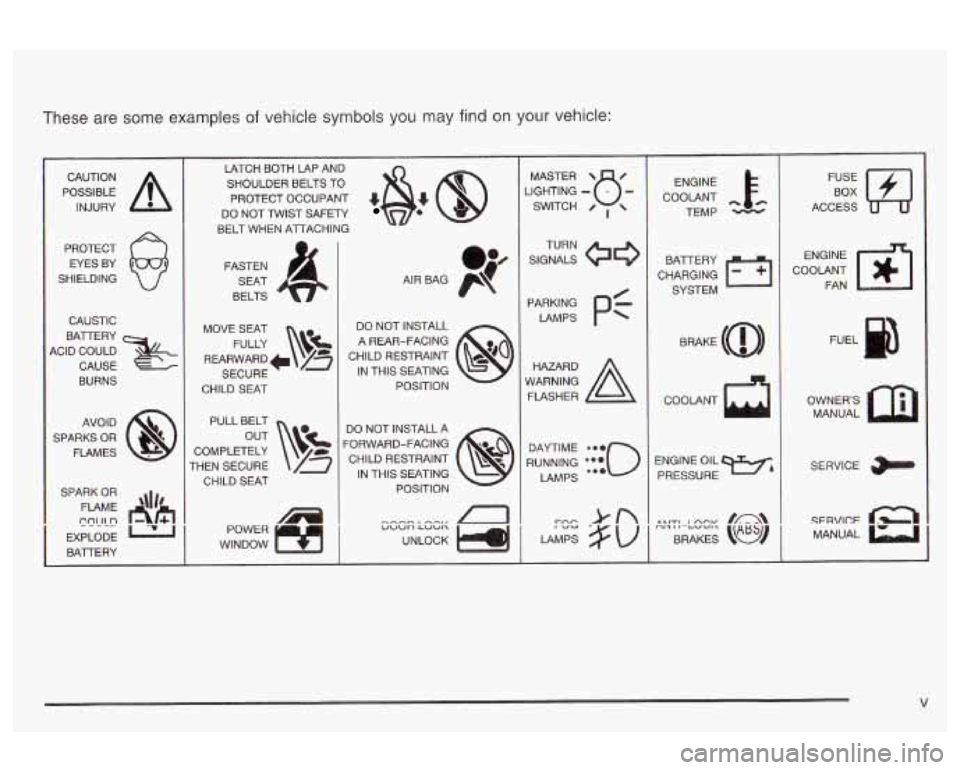
These are some examples of vehicle symbols you may find on your vehicle:
POSSIBLE A
CAUTION
INJURY
PROTECT EYES BY
SHIELDING
CAUSTIC
BATTERY
ACID COULD CAUSE
BURNS
AVO1 D
1 SPARKS OR
1 FLAMES
1 BATTERY LATCH BOTH LAP AND
SHOULDER BELTS TO
PROTECT OCCUPANT
48: @
DO NOT TWIST SAFETY
BELT WHEN ATTACHING
FASTEN SEAT
BELTS
MOVE SEAT FULLY
\!$
REARWARD+ /z
SECURE
CHILD SEAT
PULL BELT
COMPLETELY
THEN SECURE CHILD SEAT
I
1
DO NOT INSTALL
A REAR-FACING
CHILD RESTRAINT IN THIS SEATING
POSITION
DO NOT INSTALL A
'ORWARD-FACING CHILD RESTRAINT
IN THIS SEATING
POSITION
--,.-. ,.,.,, a uvun Luun
UNLOCK JGHTING
- MASTER SWITCH B- / ,
SIGNALS @+
TURN
PARKING
pf
LAMPS
DAYTIME
**a
RUNNING y.:
LAMPS 0
ENGINE
COOLANT TEMP
CHARGING
I-]
BATTERY SYSTEM
COOLANT
d
ENGINE OIL
PRESSURE
Wb
ENGINE
COOLANT FAN
OWNERS MANUAL
SERVICE
SFRVICF
MANUAL
V
Page 91 of 354
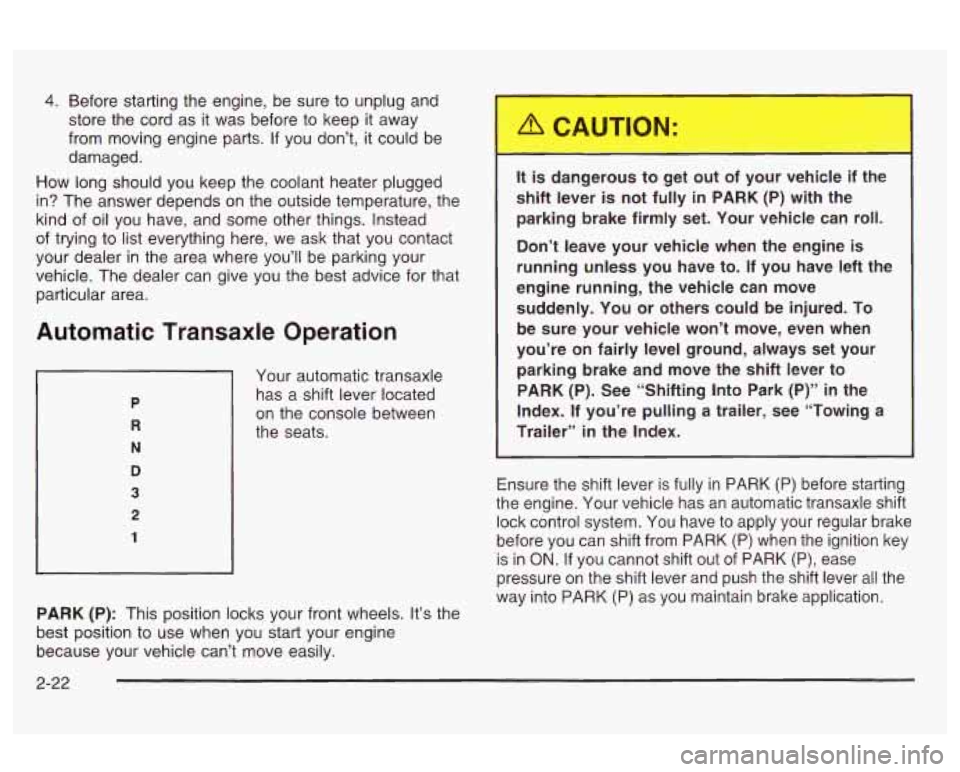
4. Before starting the engine, be sure to unplug and
store the cord as it was before to keep it away
from moving engine parts.
If you don’t, it could be
damaged.
How long should you keep the coolant heater plugged
in? The answer depends on the outside temperature, the
kind of oil you have, and some other things. Instead
of trying to list everything here, we ask that you contact
your dealer in the area where you’ll be parking your
vehicle. The dealer can give you the best advice for that
particular area.
Automatic Transaxle Operation
Your automatic transaxle
has a shift lever located
on the console between
the seats.
PARK (P): This position locks your front wheels. It’s the
best position to use when you start your engine
because your vehicle can’t move easily.
It igerous to get out of your vehicle if the
shift lever
is not fully in PARK (P) with the
parking brake firmly set. Your vehicle can roll.
Don’t leave your vehicle when the engine is
running unless you have to.
If you have left the
engine running, the vehicle can move
suddenly. You
or others could be injured. To
be sure your vehicle won’t move, even when
you’re on fairly level ground, always set your
parking brake and move the shift lever to
PARK (P). See “Shifting Into Park (P)” in the
Index. If you’re pulling a trailer, see “Towing a
Trailer”
in the Index.
Ensure the shift lever is fully in PARK (P) before starting
the engine. Your vehicle has an automatic transaxle shift
lock control system. You have to apply your regular brake
before you can shift from PARK
(P) when the ignition key
is
in ON. If you cannot shift out of PARK (P), ease
pressure on the shift lever and push the shift lever all the
way into PARK (P) as you maintain brake application.
2-22
Page 106 of 354
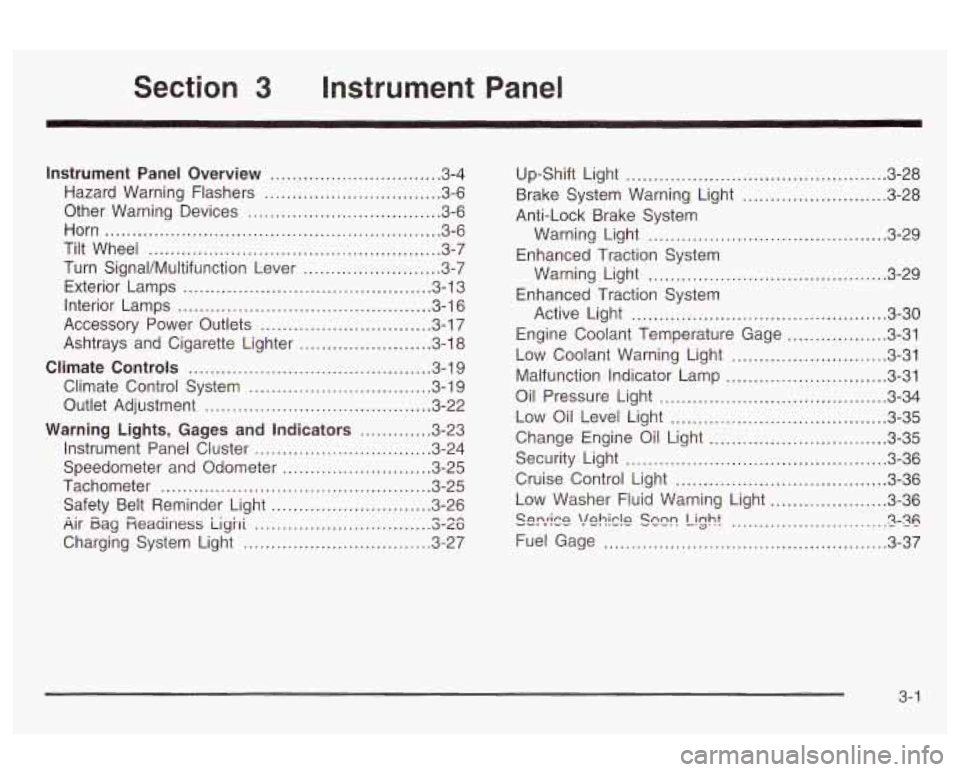
Section 3 Instrument Panel
Instrument Panel Overview ............................... 3.4
Hazard Warning Flashers
.......... .............. 3.6
Other Warning Devices
................................... 3.6
Horn
............................................................. 3.6
Tilt Wheel
..................................................... 3.7
Turn SignaVMultifunction Lever
......................... 3.7
Exterior Lamps
............................................. 3.13
Interior Lamps
.............................................. 3.16
Accessory Power Outlets
............................... 3.17
Ashtrays and Cigarette Lighter
........................ 3.18
Climate Controls
........................................... -3-1 9
Climate Control System
................................. 3.19
Outlet Adjustment
......................................... 3.22
Warning Lights, Gages and Indicators
............. 3.23
Instrument Panel Cluster
................................ 3.24
Speedometer and Odometer
........................... 3.25
Tachometer
................................................. 3.25
Safety Belt Reminder Light
............................. 3.26
Air
Eag Reauiness iighi 3-LW
Charging System Light .................................. 3.27
fi cln ................................
Up-Shift Light .............................. .......... 3-28
Brake System Warning Light
........, .......... 3-28
Anti-Lock Brake System
Enhanced Traction System
Enhanced Traction System
Warning
bight
........................................ 3-29
Warning Light
........................................... 3-29
Active Light
.............................................. 3-30
Engine Coolant Temperature Gage
.................. 3-31
Low Coolant Warning Light
............................ 3-31
Malfunction Indicator Lamp
............................. 3-31
Oil Pressure Light
......................................... 3-34
Low Oil Level Light
....................................... 3-35
Security Light
............................................... 3-36
Cruise Control Light
...................................... 3-36
%??:ice ‘!ehic!n see!? Light ........................... ._ 2-36
Fuel Gage ................................................... 3-37
Change Engine
Oil Light
................................ 3-35
Low Washer Fluid Warning Light
..................... 3-36
3-
1
Page 139 of 354
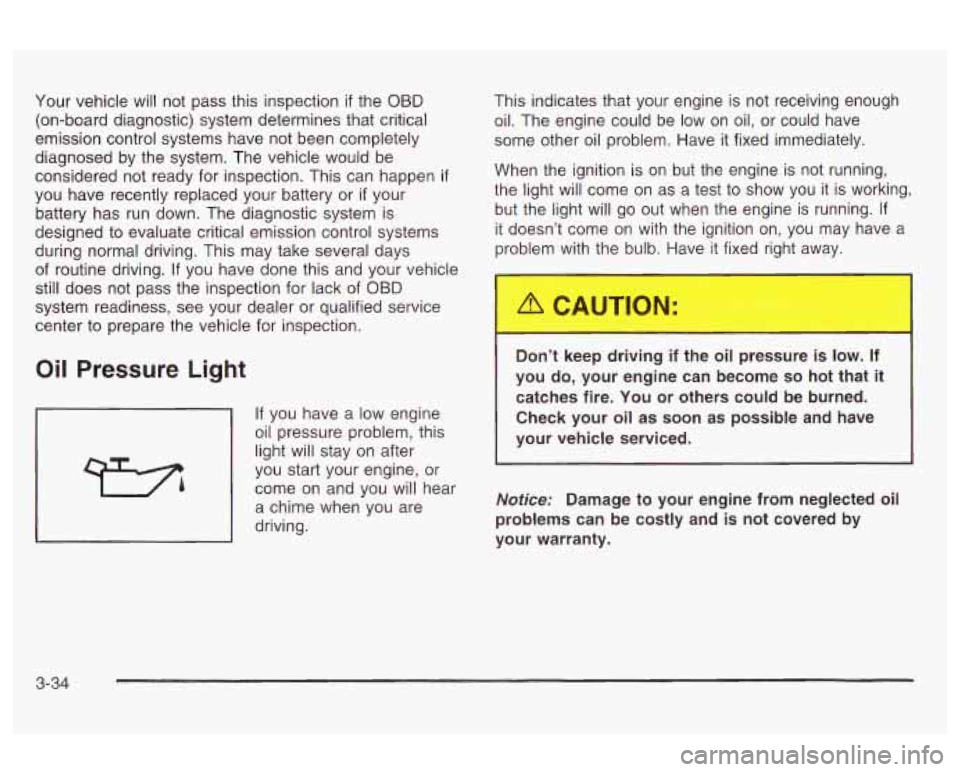
Your vehicle will not pass this inspection if the OBD
(on-board diagnostic) system determines that critical
emission control systems have not been completely
diagnosed by the system. The vehicle would be
considered not ready for inspection. This can happen it
you have recently replaced your battery or
if your
battery has run down. The diagnostic system is
designed to evaluate critical emission control systems
during normal driving. This may take several days
of routine driving.
If you have done this and your vehicle
still does not pass the inspection for lack
of OBD
system readiness, see your dealer or qualified service
center to prepare the vehicle for inspection.
Oil Pressure Light
If you have a low engine
oil pressure problem, this
light will stay on after
you start your engine, or
come on and you will hear
a chime when you are
driving. This indicates that
your engine is not receiving enough
oil. The engine could be low on oil, or could have
some other oil problem. Have it fixed immediately.
When the ignition is on but the engine is not running,
the light will come on as a test to show you it is working,
but the light will go out when the engine is running. If
it doesn’t come on with the ignition
on, you may have a
problem with the bulb. Have it fixed right away.
Don’t keer ing
if the oil pressi.. - is low. If
you do, your engine can become so hot that it
catches fire. You or others could be burned.
Check your oil as soon as possible and have
your vehicle serviced.
Notice: Damage to your engine from neglected oil
problems can be costly and
is not covered by
your warranty.
3-34
Page 195 of 354
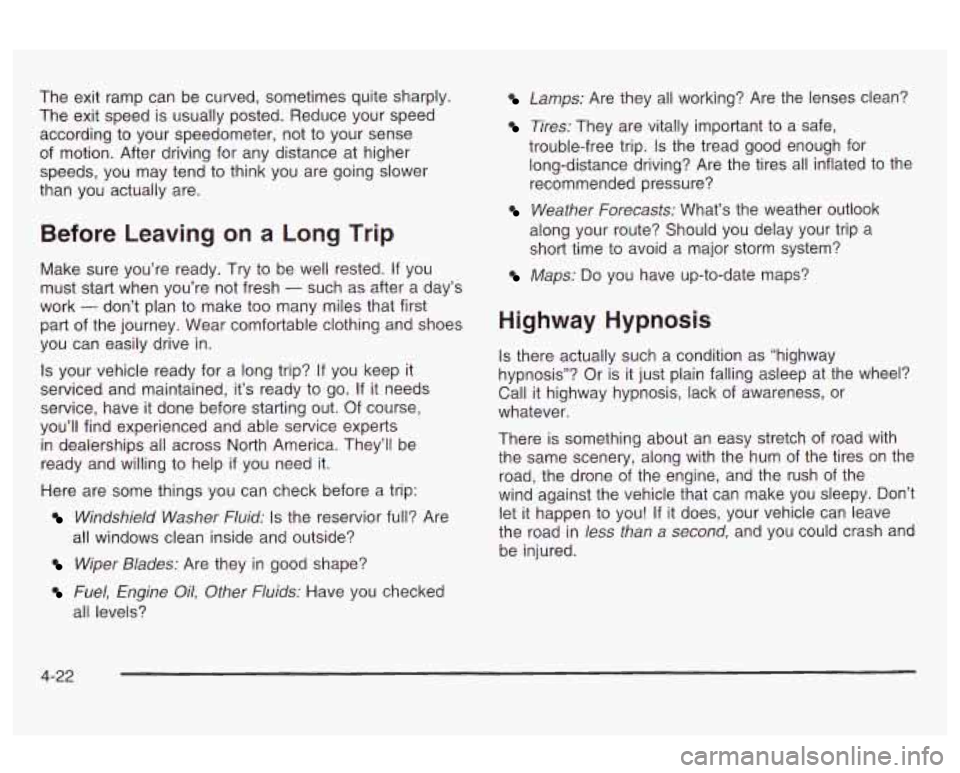
The exit ramp can be curved, sometimes quite sharply.
The exit speed
is usually posted. Reduce your speed
according
to your speedometer, not to your sense
of motion. After driving for any distance at higher
speeds, you may tend
to think you are going slower
than you actually are.
Before Leaving on a Long Trip
Make sure you’re ready. Try to be well rested. If you
must start when you’re not fresh
- such as after a day’s
work
- don’t plan to make too many miles that first
part of the journey. Wear comfortable clothing and shoes
you can easily drive in.
Is your vehicle ready for a long trip?
If you keep it
serviced and maintained, it’s ready
to go. If it needs
service, have it done before starting out. Of course,
you’ll find experienced and able service experts
in dealerships all across North America. They’ll be
ready and willing
to help if you need it.
Here are some things you can check before a trip:
Windshield Washer Fluid: Is the reservior full? Are
all windows clean inside and outside?
Wiper Blades: Are they in good shape?
Lamps: Are they all working? Are the lenses clean?
Tires: They are vitally important to a safe,
trouble-free trip. Is the tread good enough for
long-distance driving? Are the tires all inflated to the
recommended pressure?
Weather Forecasts: What’s the weather outlook
along your route? Should you delay your trip a
short time
to avoid a major storm system?
Maps: Do you have up-to-date maps?
Highway Hypnosis
Is there actually such a condition as “highway
hypnosis”? Or is it just plain falling asleep at the wheel?
Call it highway hypnosis, lack of awareness, or
whatever.
There is something about an easy stretch of road with
the same scenery, along with the hum of the tires on the
road, the drone of the engine, and the rush of the
wind against the vehicle that can make you sleepy. Don’t
let it happen to you!
If it does, your vehicle can leave
the road in
less than a second, and you could crash and
be injured.
Fuel, Engine Oil, Other Fluids: Have you checked
all levels?
4-22
Page 244 of 354
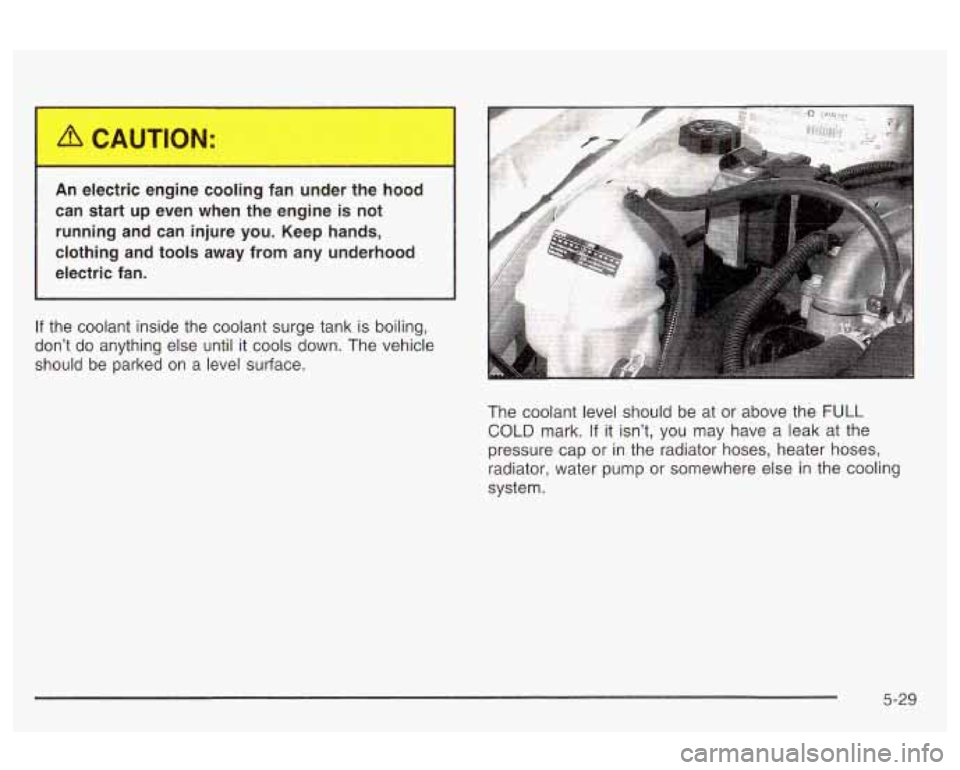
An electric engine cooling fan under the hood
can start up even when the engine is not
running and can injure you. Keep hands,
clothing and tools away from any underhood
electric fan.
If the coolant inside the coolant surge tank is boiling,
don’t do anything else until it cools down. The vehicle
should be parked on a level surface.
The coolant level should be at or above the
FULL
COLD mark. If it isn’t, you may have a leak at the
pressure cap or in the radiator hoses, heater hoses,
radiator, water pump or somewhere else in the cooling
system.
5-29
Page 312 of 354
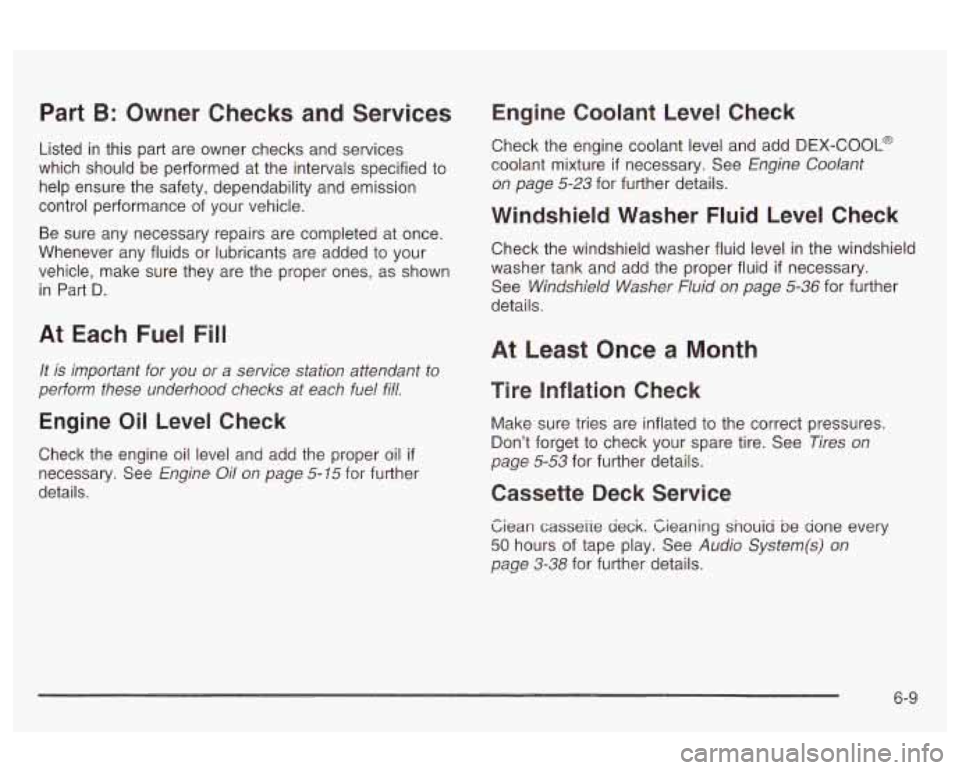
Part B: Owner Checks and Services
Listed in this part are owner checks and services
which should be performed at the intervals specified to
help ensure the safety, dependability and emission
control performance of your vehicle.
Be sure any necessary repairs are completed at once.
Whenever any fluids or lubricants are added to your
vehicle, make sure they are the proper ones, as shown
in Part
D.
At Each Fuel Fill
It is important for you or a service station attendant to
perform these Lmderhood checks at each fuel fil!.
Engine Oil Level Check
Check the engine oil level and add the proper oil if
necessary. See Engine Oil on page 5-15 for further
details.
Engine Coolant Level Check
Check the engine coolant level and add DEX-COOL@
coolant mixture
if necessary. See Engine Coolant
on page
5-23 for further details.
Windshield Washer Fluid Level Check
Check the windshield washer fluid level in the windshield
washer tank and add the proper fluid
if necessary.
See
Windshield Washer Fluid on page 5-36 for further
details.
At Least Once a Month
Tire Inreation Check
Make sure tries are inflated to the correct pressures.
Don’t forget to check your spare tire. See
Tires on
page 5-53 for further details.
Cassette Deck Service
Ziean casseiire deck. Zieaning snouid be done every
50 hours of tape play. See Audio System(s) on
page
3-38 for further details.
6-9
Page 341 of 354
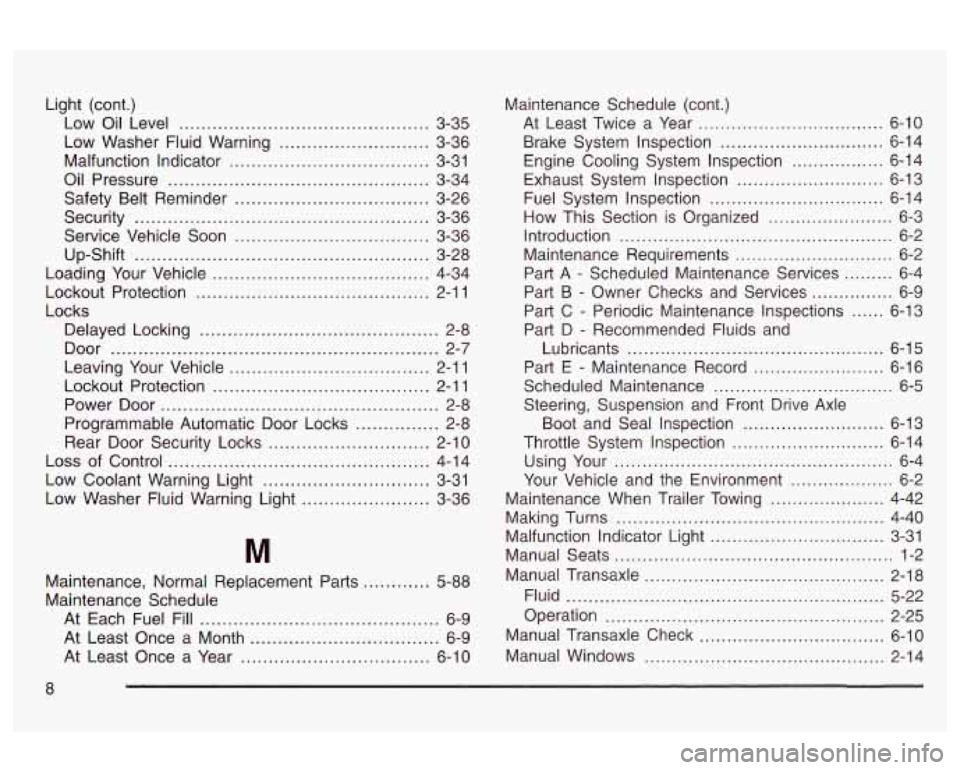
Light (cont.) Low Oil Level
............................................. 3-35
Low Washer Fluid Warning
........................... 3-36
Malfunction Indicator
.................................... 3-31
Oil Pressure
............................................... 3-34
Safety Belt Reminder
................................... 3-26
Security
..................................................... 3-36
Service Vehicle Soon
................................... 3-36
Up-Shift
..................................................... 3-28
Loading Your Vehicle
....................................... 4-34
Lockout Protection
.......................................... 2-1 1
Locks Delayed Locking
.......................... ...... 2-8
Door
.......................................... .......... 2-7
Leaving Your Vehicle
........................ .... 2-11
Lockout Protection
........................... .... 2-11
Power Door
.................................................. 2-8
Programmable Automatic Door Locks
............... 2-8
Rear Door Security Locks
............................. 2-10
Loss of Control
............................................... 4-14
Low Coolant Warning Light
.............................. 3-31
Low Washer Fluid Warning Light
....................... 3-36
M
Maintenance. Normal Replacement Parts ........ 5-88
Maintenance Schedule At Each Fuel Fill
........................................... 6-9
At Least Once a Month
.................................. 6-9
At Least Once a Year
.................................. 6-10 Maintenance Schedule (cont.)
At Least Twice a Year
.................................. 6-10
Brake System Inspection
.............................. 6-14
Engine Cooling System Inspection
................. 6-14
Exhaust System Inspection
........................... 6-13
Fuel System Inspection
................................ 6-14
How This Section is Organized
....................... 6-3
Introduction
.................................................. 6-2
Maintenance Requirements
............................. 6-2
Part A
- Scheduled Maintenance Services ......... 6-4
Part B
- Owner Checks and Services ............... 6-9
Part C
- Periodic Maintenance Inspections ...... 6-13
Part D
- Recommended Fluids and
Lubricants
........................................... 6-15
Part
E - Maintenance Record ........................ 6-16
Scheduled Maintenance
................................. 6-5
Steering, Suspension and Front Drive Axle
Boot and Seal Inspection
.......................... 6-13
Throttle System Inspection
............................ 6-14
Using Your
................................................... 6-4
Your Vehicle and the Environment
............... 6-2
Maintenance When Trailer Towing
.... ..... 4-42
Making Turns
.................................... ..... 4-40
Malfunction Indicator Light
............................ 3-31
Manual Seats
................................................... 1-2
Manual Transaxle
............................................ 2-18
Fluid
.......................................................... 5-22
Operation
................................................... 2-25
Manual Transaxle Check
.................................. 6-10
Manual Windows
............................................ 2-14
8
Page 342 of 354
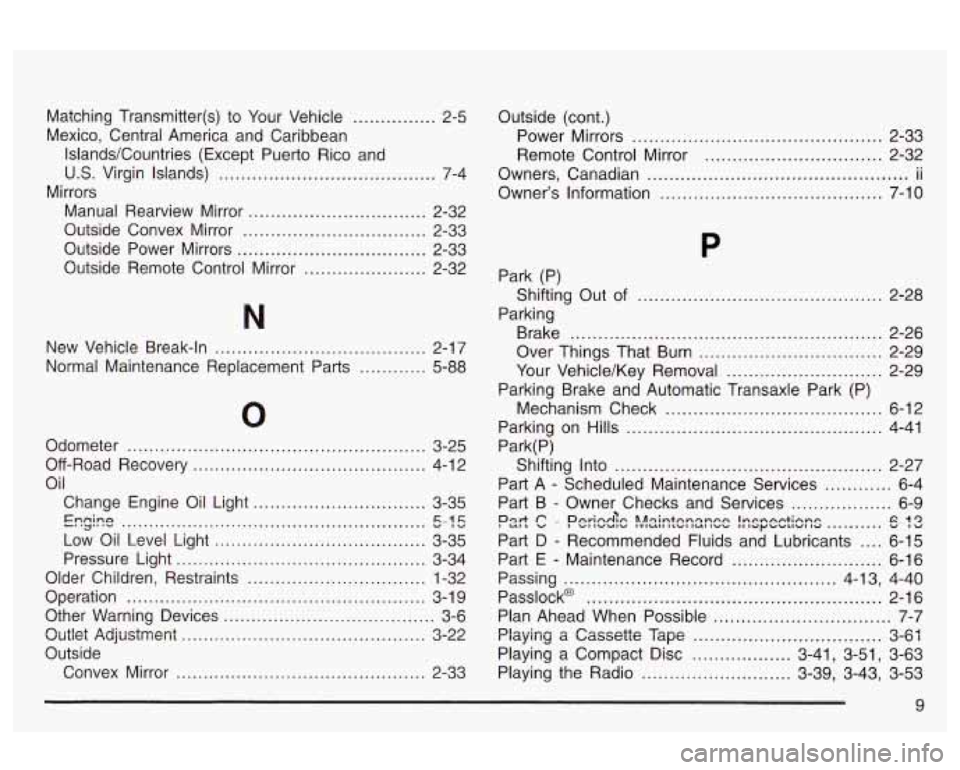
Matching Transmitter(s) to Your Vehicle ............... 2-5
Mexico. Central America and Caribbean
IslandslCountries (Except Puerto Rico and
U.S. Virgin Islands) ....................................... 7-4
Manual Rearview Mirror
................................ 2-32
Outside Convex Mirror
................................. 2-33
Outside Power Mirrors
.................................. 2-33
Outside Remote Control Mirror
...................... 2-32
Mirrors
New Vehicle Break-In
...................................... 2-17
Normal Maintenance Replacement Parts
............ 5-88
0
Odometer ...................................................... 3-25
Off-Road Recovery
.......................................... 4-1 2
Oil Change Engine Oil Light
............................... 3-35
Low Oil bevel Light
...................................... 3-35
Pressure Light
............................................. 3-34
Older Children, Restraints
................................ 1-32
Operation
...................................................... 3-1 9
Other Warning Devices
...................................... 3-6
Outside
Engine ....................................................... " E-! 5
Outlet Adjiisti?ieiit ............................................ 3-22
Convex Mirror ............................................. 2-33 Outside
(cont.)
Power Mirrors
............................................. 2-33
Remote Control Mirror
................................ 2-32
Owners. Canadian
............................................... ii
Owner's Information
........................................ 7-10
Park (P)
Parking Shifting
Out
of ......... ~~~~ ................ 2-28
Brake
............................ ................ 2-26
Over Things That Burn
............................. 2-29
Your Vehicle/Key Removal
............................ 2-29
Parking Brake and Automatic Transax!e Park (P)
Mechanism Check
....................................... 6-12
Parking on Hills
.............................................. 4-41
Park(
P)
Shifting Into ................................................ 2-27
Part A - Scheduled Maintenance Services ............ 6-4
Part B
- Owner Checks and Services .................. 6-9
Part D
- Recommended Fluids and Lubricants .... 6-15
Part
E - Maintenance Record ........................... 6-16
Passing
................................................. 4-13, 4-40
Passlock@
..................................................... 2-16
Plan Ahead When Possible
................................ 7-7
Playing a Cassette Tape .................................. 3-61
Playing a Compact Disc .................. 3-41, 3-51, 3-63
Playing the Radio
........................... 3-39, 3-43, 3-53
I UI k G . Pericdlc ??lzintzn2ncc Inspcticns .......... 8-13
9